Physical Address
304 North Cardinal St.
Dorchester Center, MA 02124
Non-glial tumors constitute the bulk of neoplasms encountered in the central nervous system (CNS). They include a wide variety of tumor types and a spectrum of behaviors ranging from benign to highly malignant. This chapter discusses some of the more commonly encountered non-glial tumors of the CNS.
Meningiomas account for approximately 36% of primary intracranial tumors. Lesions arise from arachnoidal cap cells, which are generally situated proximal to the meninges and dura. Occasionally, arachnoidal cap cell nests may be found in unusual locations, thus accounting for some of the more unusual sites of origin for these tumors (intraventricular region, head, and neck). The lesion has a clear female preponderance, although high-grade meningiomas are more commonly encountered in males. Meningiomas may arise at any age, but the peak incidence is in elderly adults (mean age 65 years). There is a known association of meningiomas with neurofibromatosis type 2, previous radiation therapy, and certain gynecologic malignancies such as breast carcinoma (a majority of tumors [nearly 50%–80%] express progesterone receptors). Radiation-induced meningiomas present at a younger age and are often more aggressive and multifocal. Radiographically, tumors are circumscribed, uniformly contrast-enhancing, generally dural-based lesions that may have a wedge-shaped extension of tumor at the edge, referred to as the dural tail. The radiographic appearance may be altered by calcification, bone and cartilage formation, and hypervascularity.
Generally slow-growing, dural-based tumors derived from meningothelial (arachnoid cap) cells
Account for about 36% of primary intracranial neoplasms
Annual incidence rate of approximately 7.86 cases per 100,000 persons
Most arise proximal to the dura within the intracranial, orbital, and intravertebral cavities
Most common sites of origin: convexity, parasagittal region, cavernous sinus, tuberculum sella, lamina cribrosa, foramen magnum, torcular zone, thoracic (spine)
Female preponderance (F:M ratio of 1.7:1)
Can occur at any age
Most common in middle-aged and elderly patients; peak during the sixth and seventh decades
Atypical and anaplastic meningiomas do not show female predominance.
Manifestations dependent on location of tumor
Since they are generally slow growing, they usually produce symptoms by compression of adjacent structures—focal neural deficits, headaches, increased intracranial pressure, personality changes, and seizures are the most common symptoms.
May cause hyperostosis of the overlying skull
Circumscribed isodense dural masses that enhance with contrast
May show evidence of calcification, bone, or cartilage
Dural tail: wedge-shaped extension of tumor at the edge, contrast enhancing
Anaplastic and brain invasive tumors associated with cerebral edema
Most variants have an excellent prognosis and are curable by gross total resection.
Major predictor of recurrence is the extent of surgical resection.
Rare, more aggressive variants (papillary, chordoid, rhabdoid, clear cell, atypical, and anaplastic tumors) are more likely to recur and, in some cases, metastasize.
Recurrence rates: WHO grade 1, 7%–25%; WHO grade 2, 29%–52%; WHO grade 3, 50%–94%
Higher cell proliferative labeling indices correlate with increased risk of recurrence.
Radiotherapy used to treat higher-grade and subtotally resected tumors.
Grossly, tumors are well demarcated and generally compress the adjacent parenchyma ( Fig. 10.1A ). Occasional tumors grow in a flat, en plaque pattern. A subset of atypical and anaplastic meningiomas may invade neural parenchyma. Hyperostosis of the overlying skull secondary to bone invasion may be encountered. Tumors may infiltrate skin and extracranial structures.
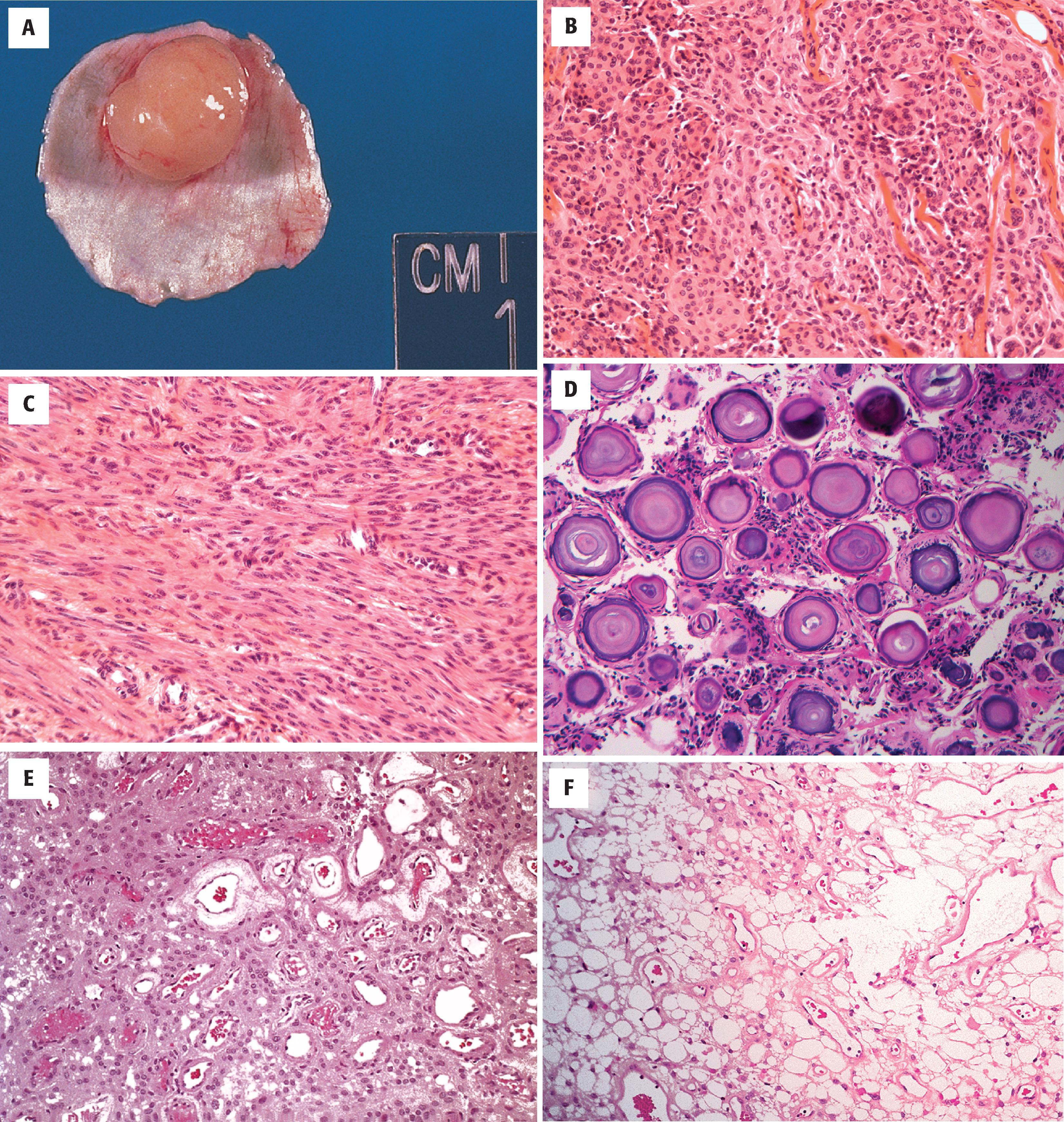
The majority of meningiomas are of the meningothelial, fibrous, or transitional types and are World Health Organization (WHO) grade 1 tumors ( Table 10.1 ). Specific histologic subtypes that have been associated with more aggressive behavior include chordoid and clear cell tumors (WHO grade 2) ( Fig. 10.2A–B ) and papillary and rhabdoid tumors (WHO grade 3) ( Fig. 10.3A–B ). Histologic grading of tumors into the atypical (WHO grade 2) and anaplastic (malignant) (WHO grade 3) categories is based on mitotic activity, degree of cellularity, small cell change, prominent nucleolation, sheet-like growth pattern, necrosis, brain invasion, and lack of differentiation (see Figs. 10.2C–E and 10.3C ). Brain invasive tumors are considered WHO grade 2 lesions (see Fig. 10.2E ). Preoperative embolization to reduce intraoperative bleeding may result in tumor necrosis (see Fig. 10.2F ); necrosis in this setting should not be used to grade the tumor. Rarely, high-grade tumors can metastasize outside the CNS (see Fig. 10.3D ).
| Meningothelial (see Fig. 10.1B ) WHO grade 1 Cells arranged in lobules separated by collagenous septa Fibrous (fibroblastic) (see Fig. 10.1C ) WHO grade 1 Cells spindled and arranged in interlacing bundles Psammoma bodies and whorling of cells around vessels common Transitional (mixed) WHO grade 1 Demonstrates features of both syncytial and fibrous types Psammomatous (see Fig. 10.1D ) WHO grade 1 Abundant psammoma bodies Particularly common in the spinal cord Angiomatous (see Fig. 10.1E ) WHO grade 1 Numerous blood vessels in the background of an ordinary meningioma Microcystic (see Fig. 10.1F ) WHO grade 1 Cells with elongated processes arranged against a loose, mucoid background Secretory (see Fig. 10.1G ) WHO grade 1 Intracellular lumina with eosinophilic, PAS-positive material (pseudopsammoma bodies) Lymphoplasmacyte-rich (see Fig. 10.1H ) WHO grade 1 Extensive chronic inflammatory infiltrates Metaplastic (see Fig. 10.1H ) WHO grade 1 Focal mesenchymal differentiation (bone, cartilage, adipose, xanthomatous) |
Chordoid (see Fig. 10.2A ) WHO grade 2 Areas resembling chordoma with trabeculae of eosinophilic and vacuolated cells arranged against a myxoid background Clear cell (see Fig. 10.2B ) WHO grade 2 Polygonal cells with glycogen-rich, clear cytoplasm Atypical (see Fig. 10.2C–E ) WHO grade 2 Tumor marked by either increased mitotic activity (4 or more mitotic figures per 10 high-power fields—0.16 mm 2 ) or 3 or more of the following: increased cellularity, small cell change, prominent nucleoli, sheet-like growth pattern, or necrosis Brain invasion alone enough to designate tumor as grade 2 Papillary (see Fig. 10.3A ) WHO grade 2 Perivascular pseudopapillary pattern Rhabdoid (see Fig. 10.3B ) WHO grade 3 Presence of rhabdoid cells with eccentric nuclei and prominent eosinophilic cytoplasmic inclusions of intermediate filaments Anaplastic (malignant) (see Fig. 10.3C–D ) WHO grade 3 Tumor marked by either 20 or more mitotic figures per 10 high-power fields (0.16 mm 2 ) or excessive malignant cytology with an appearance similar to sarcoma, carcinoma, or melanoma. Tumors with TERT promotor mutations or CDKN2A mutations behave like grade 3 tumors Extracranial metastases seen most commonly in anaplastic tumors, rarely encountered in benign tumors |
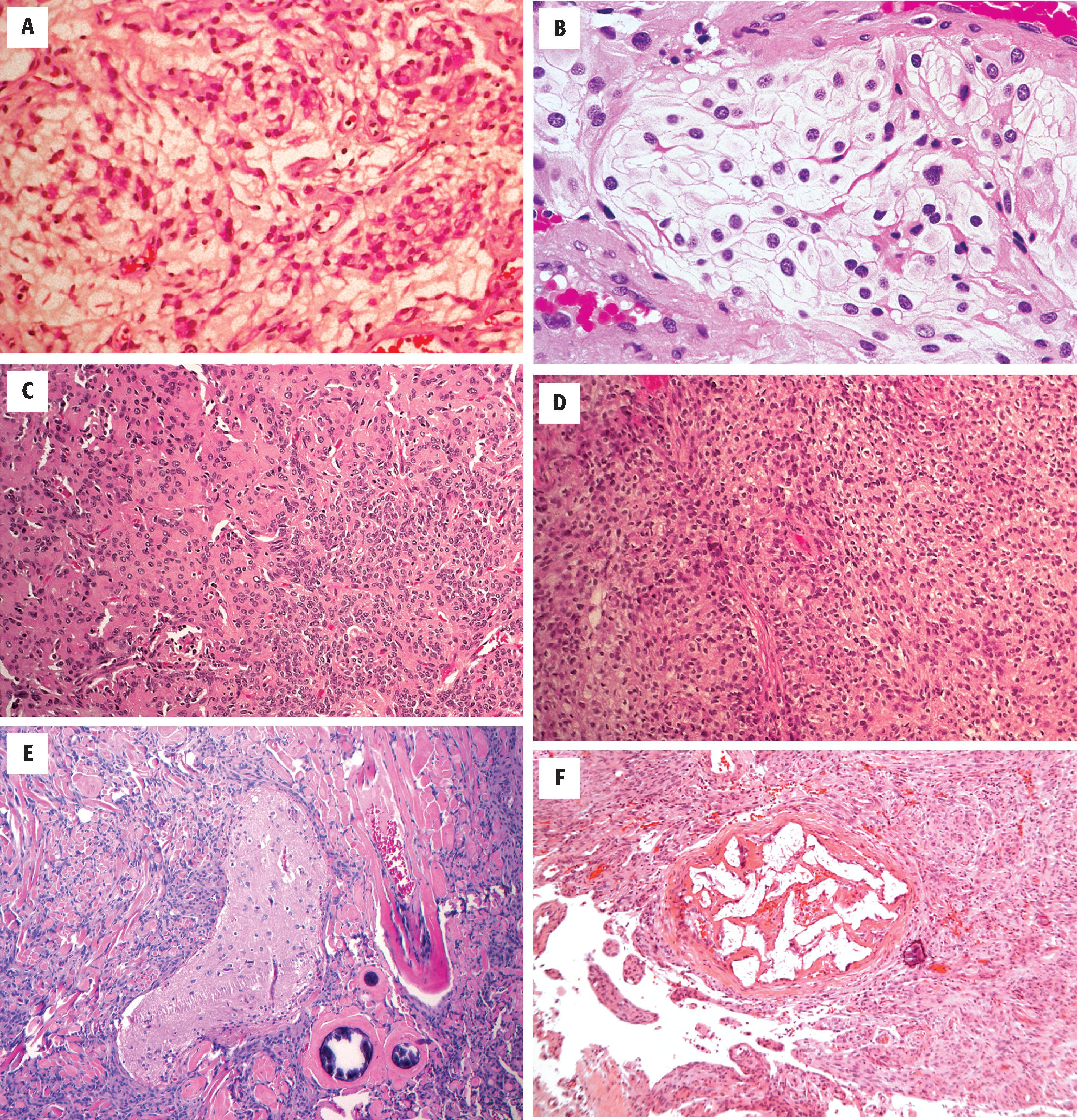
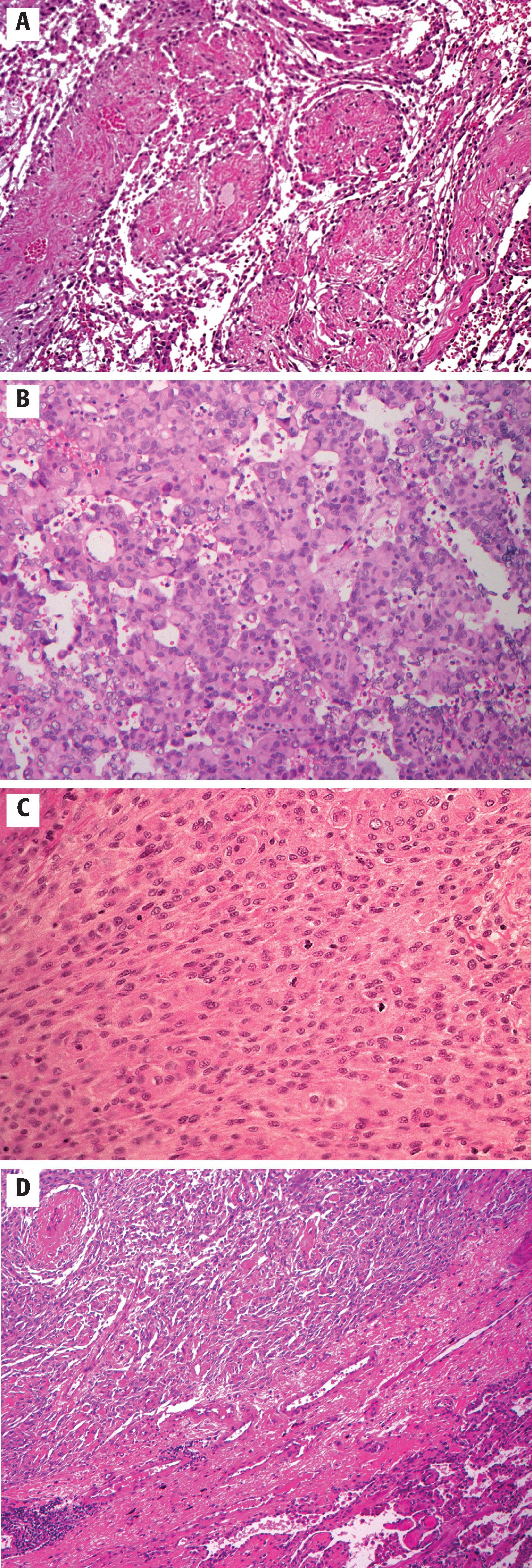
By immunohistochemistry, approximately 80% of meningiomas stain with epithelial membrane antigen (EMA), vimentin and somatostatin receptor 2a (SSTR2a) immunoexpression. Approximately 20% to 40% of tumors are immunoreactive to S-100 protein. Focal positivity with antibodies to carcinoembryonic antigen (CEA) and cytokeratins may be observed. Ki-67 labeling indices generally correlate with tumor grade. Ultrastructural examination of the tumor is marked by the presence of prominent numbers of intermediate filaments, interdigitating cell processes, and desmosomal intercellular junctions.
Dural-based, sharply demarcated, rubbery or firm mass that compresses adjacent brain parenchyma
Appearance may be altered by lipid content, cystic change, metaplastic components, vascularity, and calcification
Meningioma en plaque: flat growth pattern, most common along the sphenoid wing
Monomorphic cells arranged in a syncytium
Nuclei oval to round with inconspicuous nucleoli
Intranuclear pseudoinclusions (cytoplasmic invaginations)
Psammoma bodies common
See Table 10.1 for histologic variants
Prominent intermediate filaments, interdigitating cell processes, and desmosomal intercellular functions
Vimentin and SSTR2a: almost all are positive
EMA: about 80% focally positive
CEA, cytokeratins: focally positive in a minority of tumors; S-100 protein—20% to 40% focal positivity
Glial fibrillary acidic protein (GFAP): negative
Ki-67/MIB-1 labeling indices generally correlate with grade
Most common cytogenetic abnormality: deletion on chromosome 22q
Mutations in the neurofibromatosis 2 gene (NF2) in 60% of sporadic tumors
Deletion of chromosome 1p and 19p21 are associated with poorer outcome
Tumors with TERT promotor mutation or CDKN2A mutation behave like grade 3 tumors
Schwannoma
Metastatic carcinoma
Astrocytoma
Sarcoma
Solitary fibrous tumor
Hemangioblastoma
Differential diagnostic considerations are numerous, given the phenotypic variability of these tumors. The fibrous variant of meningioma can be particularly problematic because of its bland spindled cell composition. Distinction of this lesion from schwannoma, especially in the cerebellopontine angle region, may be difficult. Schwannomas demonstrate diffuse S-100 protein immunoreactivity, Verocay body formation, biphasic Antoni A and Antoni B patterns, and a lack of psammoma body formation. Low-grade solitary fibrous tumors/hemangiopericytomas are generally CD34- and STAT 6-positive and marked by collagen material deposited between individual cells ( Fig. 10.4A–B ); they are negative for progesterone receptor and SSTR2a. Meningioangiomatosis is a rare neurofibromatosis type 2 associated lesion characterized by perivascular collars of meningothelial cells extending into the parenchyma ( Fig. 10.5 ), but it lacks the other worrisome histologic features that mark most brain invasive meningiomas. The other group of meningiomas that tend to be problematic with regard to the differential diagnosis includes the anaplastic tumors. According to WHO criteria, these tumors have areas that resemble carcinoma, melanoma, or sarcoma. Distinction of high-grade meningiomas from these various lesions may be challenging. In general, carcinomas demonstrate more widespread cytokeratin immunoreactivity. Melanomas are positive for S-100, HMB-45, and melan A. Differentiation of nondescript high-grade sarcomas from spindled, high-grade meningiomas may be difficult and requires ultrastructural evaluation in certain cases. Occasionally, high-grade astrocytomas may also have a spindled cell or sarcomatous appearance (gliosarcomas). Most gliomas demonstrate some degree of GFAP immunoreactivity. Hemangioblastomas and clear cell carcinomas show clear cytoplasmic features which may resemble clear cell meningioma. Inhibin (for hemangioblastoma) and PAX 8 positivity (for renal cell carcinomas) will respectively stain each of these lesions and help differentiate them from clear cell meningioma.
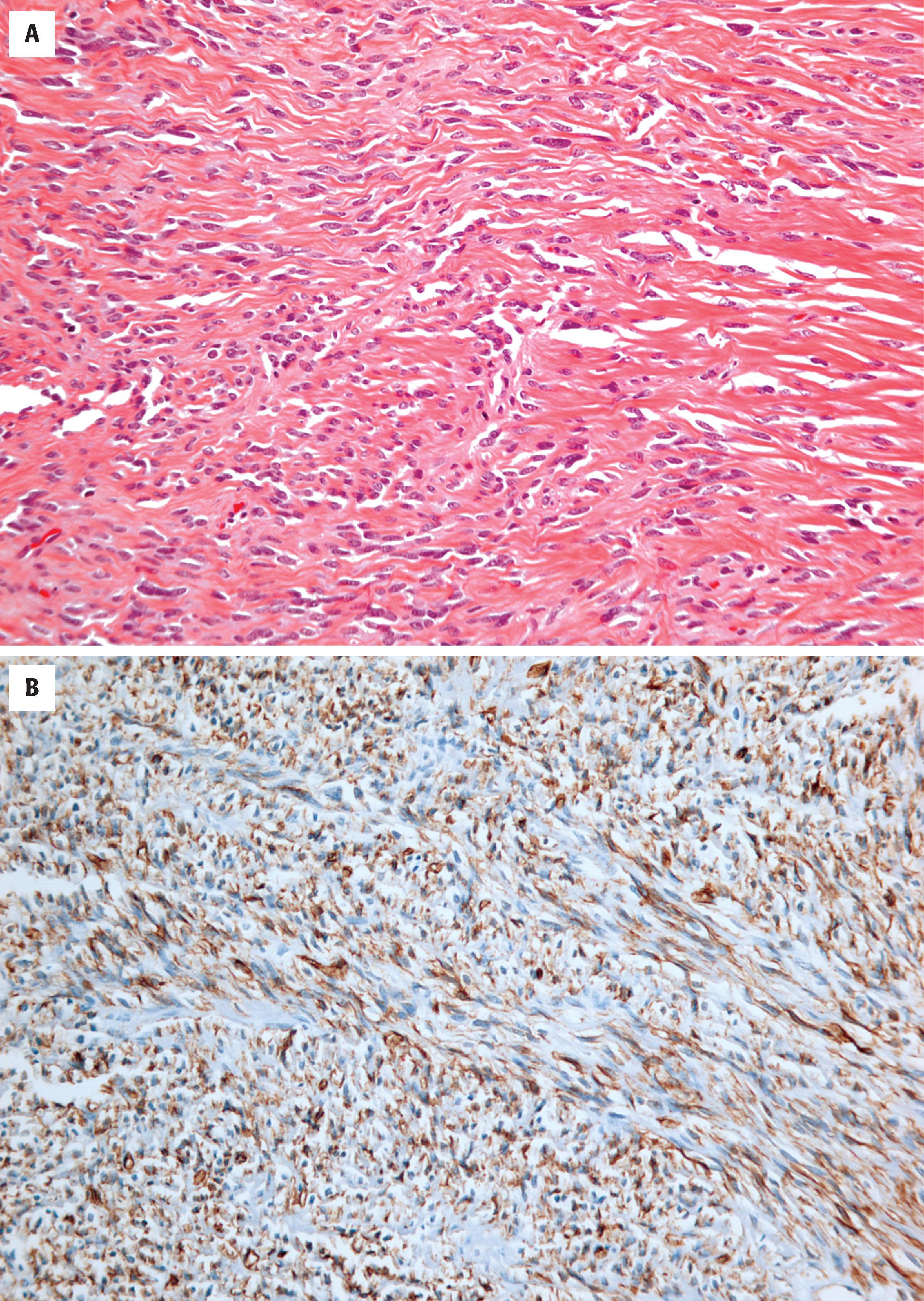
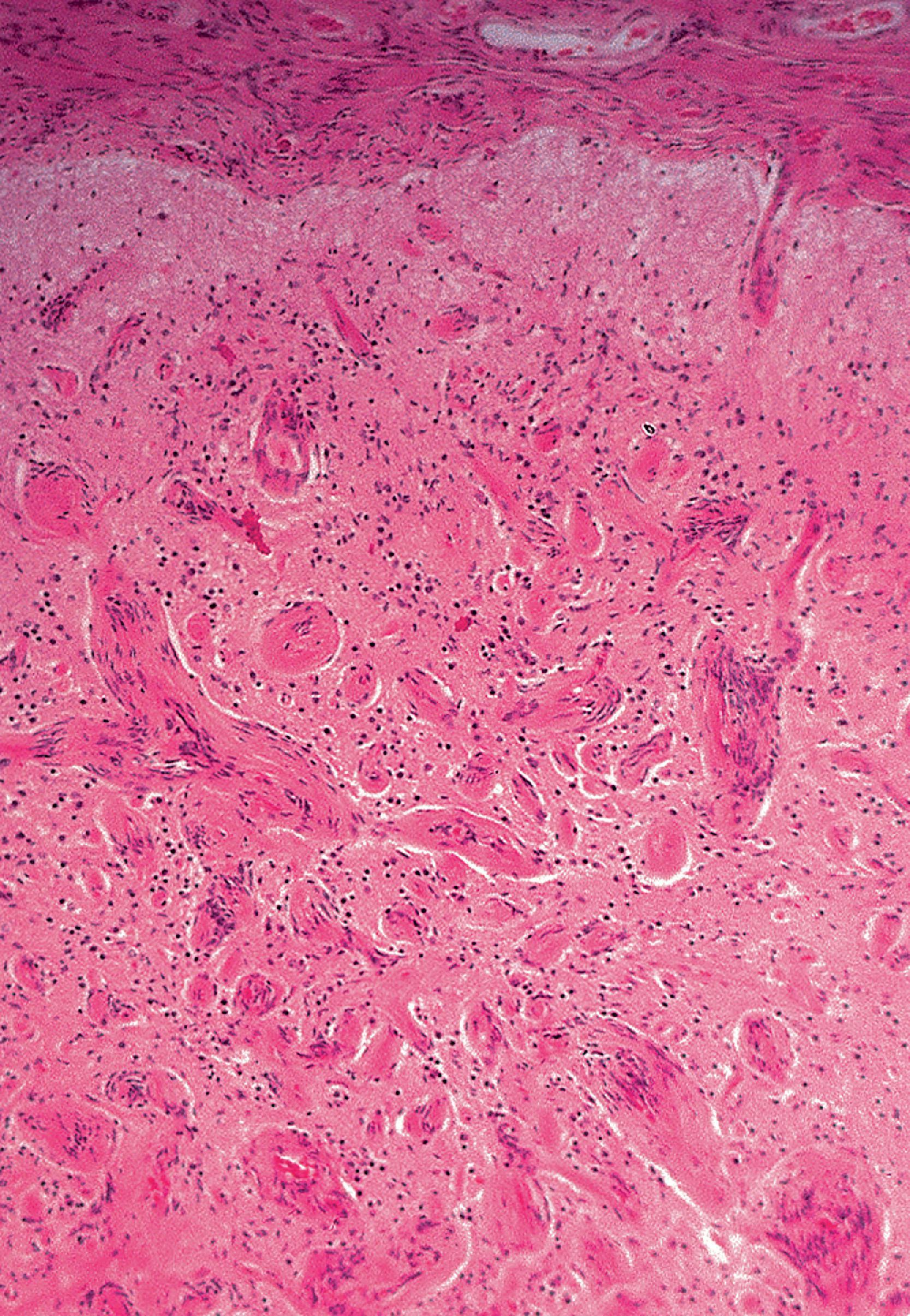
Overall, the majority of meningiomas behave in a benign clinical fashion and are amenable to surgical resection. Grade II tumors are more likely to recur in a shorter interval after subtotal resection, whereas malignant or anaplastic tumors are more likely to recur as well as metastasize. Radiotherapy may be used in managing the high-grade tumors and lesions that are particularly aggressive and associated with multiple recurrences.
Mesenchymal tumors may arise at any age and generally show no sex predilection. They run the gamut from benign lesions such as lipoma to malignant tumors such as sarcomas. Manifestations are primarily dependent on location and may include focal neural deficits, symptoms related to increased intracranial pressure, and seizures. Imaging studies tend to be nonspecific and are dependent on the tissue types present. Sarcomas tend to be locally infiltrative and destructive lesions. There is an association of previous irradiation and the development of sarcoma.
Tumors of mesenchymal origin that arise in the CNS or dura, including benign (leiomyoma, lipoma) and malignant (sarcomas, including high-grade solitary fibrous tumor/hemangiopericytoma) neoplasms
Lipoma is the most common of benign tumors—0.4% of intracranial tumors; sarcomas represent 0.2% of intracranial tumors, with solitary fibrous tumor, fibrosarcoma, and pleomorphic sarcoma/malignant fibrous histiocytoma as the most common types.
More commonly dural than parenchymal based
Most supratentorial
Lipomas usually midline; hemangiomas most commonly bone based; rhabdomyosarcomas more often infratentorial; chondromas, chondrosarcomas and osteosarcomas skull based
Occur at any age; rhabdomyosarcoma more common in children, and solitary fibrous tumor more common in adults
Generally no sex predilection; hemangiopericytomas show a slight male preponderance (M:F ratio of 1.4:1)
Manifestations dependent on location and most commonly include focal neural deficits, increased intracranial pressure, and seizures
Primary leiomyosarcomas are associated with Epstein-Barr virus infection and acquired immunodeficiency syndrome (AIDS).
Imaging appearances generally nonspecific
Lipomas with high signal intensity on T1-weighted magnetic resonance imaging (MRI)
Sarcomas may be associated with lytic destruction of adjacent bone.
Benign tumors can be completely resected with a favorable prognosis.
Sarcomas have a high incidence of recurrence and metastasis with a poor outcome despite aggressive irradiation and chemotherapy.
Benign lesions tend to be well circumscribed in contrast to sarcomas, which are often infiltrative. Sarcomas may have a fleshy appearance on sectioning and are frequently marked by areas of necrosis and hemorrhage.
Microscopically, a myriad of tumor types fall into this general category. The most commonly encountered sarcoma type in childhood is rhabdomyosarcoma. In adults, high grade solitary fibrous tumors are the most frequently encountered sarcoma type ( Fig. 10.6A–B ); these latter tumors are marked by randomly oriented cells with scant cytoplasm and a prominent staghorn vascular pattern. By immunohistochemistry, solitary fibrous tumors are generally STAT6- and CD34-positive and negative for EMA and S-100 protein (see Fig. 10.6C ). Grading is based on phenotype and mitotic counts. Criteria for subtyping sarcomas in the CNS should follow the rules for subtyping sarcoma elsewhere in the body ( Fig. 10.7A–B ). Many of these tumors represent metastasis from extra-CNS sites.
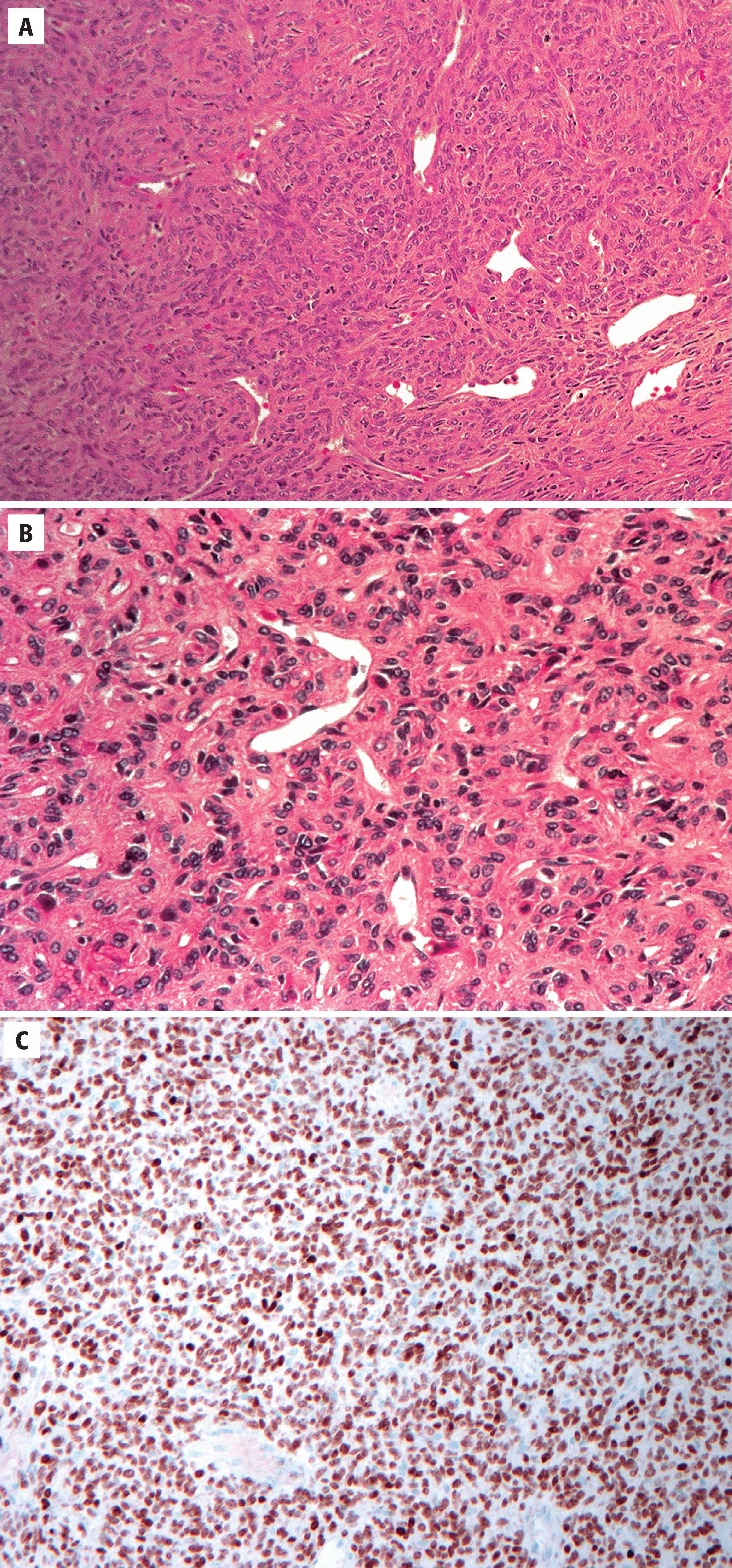
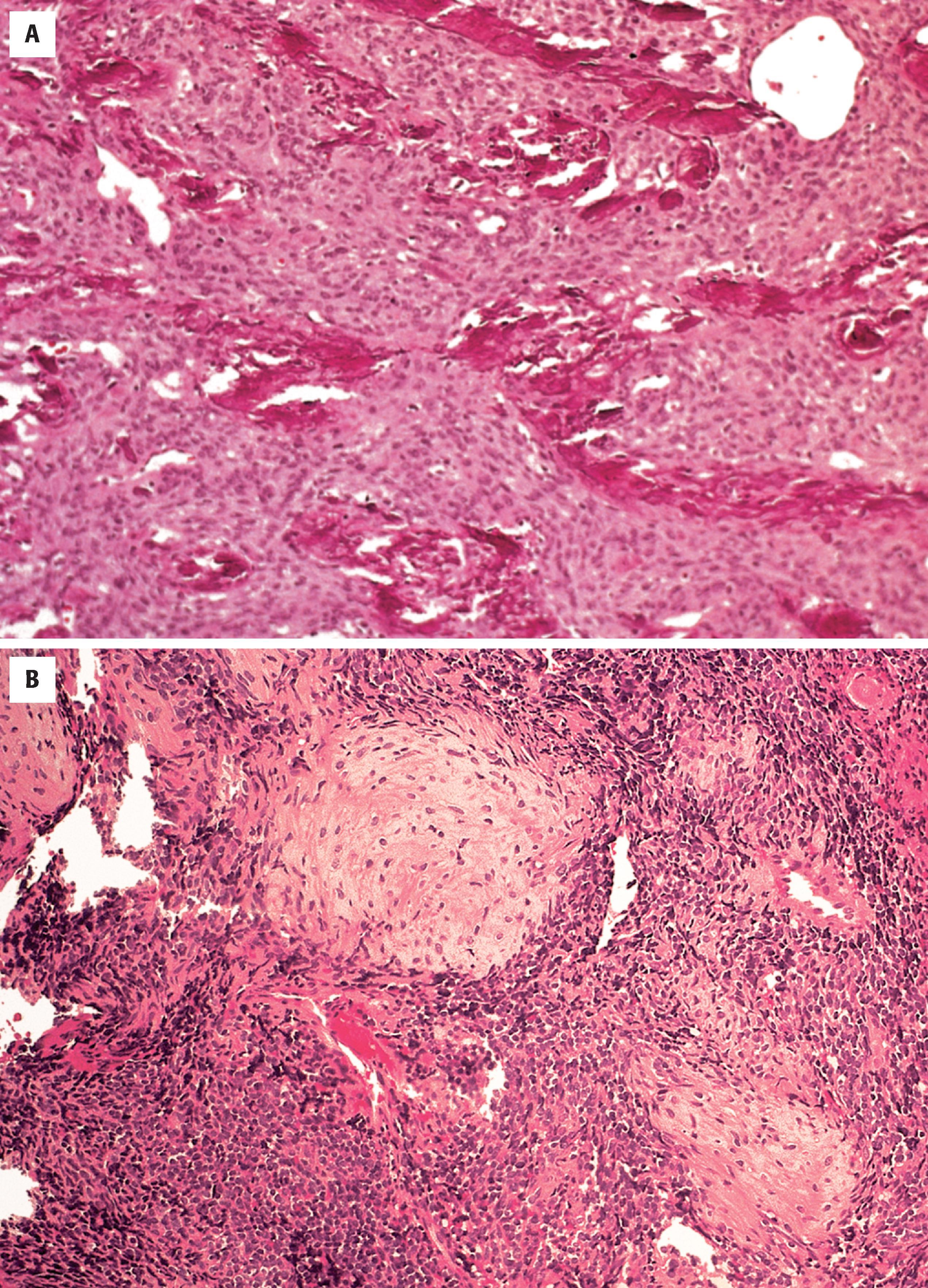
Depends on tumor type
Benign lesions tend to be circumscribed.
Sarcomas may be grossly well delineated with a firm and fleshy cut surface; necrosis and hemorrhage are common.
Benign lesions resemble normal tissue types.
Sarcomas demonstrate features by light microscopy, immunohistochemistry, or ultrastructural examination that indicate their lineage.
Sarcomas are marked by increased cellularity, nuclear atypia, mitotic activity, and necrosis.
The solitary fibrous tumor phenotype tumors are composed of randomly oriented plump cells with scant cytoplasm and a prominent “staghorn” vascular pattern.
The solitary fibrous tumors may be WHO grade 2 or 3 based on a cutoff of 5 mitotic figures per 10 high-power fields and the presence of necrosis (grade 3).
Depend on tumor type
Solitary fibrous tumor cells contain small bundles of intermediate filaments and lack desmosomes or gap junctions.
Depend on tumor type
Solitary fibrous tumor: positive for vimentin, STAT6, CD34, CD99 and BCL-2; negative for EMA, SSTR2a, SOX 10, progesterone receptor, and S-100 protein
Solitary fibrous tumors are genetically distinct from meningiomas; may have NAB2-STAT6 fusion.
Other recently recognized and rare sarcomas and mesenchymal tumors are associated with FET-CREB fusions, CIC alterations, and DICER1 mutations.
Gliomas with mesenchymal differentiation, including gliosarcoma
Meningioma (depending on grade: fibrous, atypical or anaplastic meningioma)
Schwannoma
Metastatic carcinoma, melanoma, or sarcoma
Differential diagnostic considerations for higher-grade tumors include metastatic spindled carcinomas, melanomas, other sarcoma types, anaplastic meningiomas, and gliosarcoma. In contrast to the majority of sarcomas, metastatic carcinomas demonstrate some degree of cytokeratin immunoreactivity, whereas melanomas demonstrate S-100, melan A, SOX 10, and HMB-45 immunoreactivity. STAT6 may be helpful in distinguishing solitary fibrous tumor/hemangiopericytoma from other nondescript high-grade sarcomas or anaplastic meningiomas if no differentiating features are evident. Lower grade lesions may resemble fibrous meningiomas or schwannomas; again, immunohistochemistry may be helpful in sorting out these differentials. Gliosarcomas contain a glioblastoma component that is GFAP immunoreactive.
Benign tumors may be completely resected with a favorable prognosis. Sarcomas have a high risk of recurrence and metastasis despite extensive surgical debulking and the use of adjuvant radiation therapy, chemotherapy, or both. Solitary fibrous tumor/hemangiopericytoma is prone to metastasize to bone, lung, and liver.
Historically, hemangioblastoma used to be considered a subtype of meningioma. In more recent years, it has been classified as a distinct tumor. The lesion may arise at any age, although it has a peak incidence during the third and fourth decades. There is no sex preference, and the tumor has a well-known association with von Hippel-Lindau disease (about a quarter of patients). Most tumors arise in the cerebellar region and commonly present with ataxia or dysmetria or cause symptoms related to obstruction of cerebrospinal fluid (CSF). Approximately 5% of tumors produce erythropoietin that results in secondary polycythemia vera. Radiographically, tumors demonstrate a cyst with an enhancing mural nodule configuration.
Tumor of uncertain histogenesis composed of stromal cells and abundant capillaries
Relatively uncommon tumor
Most commonly arise in the cerebellum; rarely arise in the brain stem, spinal cord, and supratentorium
Slight male preponderance
Peak incidence at 25 to 40 years of age
Von Hippel-Lindau tumors typically develop at a younger age.
Symptoms related to CSF obstruction: increased intracranial pressure; spinal tumors cause local compression with pain, hypesthesia, and incontinence
Associated with von Hippel-Lindau disease
5% with secondary polycythemia
Contrast-enhancing nodule associated with a cyst or syrinx
WHO grade 1 tumor
Good prognosis, curable with gross total resection
Radiotherapy may be of limited use in recurrent or nonresectable tumors.
Increased risk of multiple/multifocal tumors in von Hippel-Lindau disease.
Tumors are often generally cystic with a mural nodule or nodules. Lesions are generally well circumscribed but not encapsulated.
Histologically, tumors consist of a prominent capillary vasculature with intermingled stromal cells ( Fig. 10.8A–B ). The stromal cells generally have a vacuolated or slightly eosinophilic cytoplasm. Nuclear pleomorphism is often focally prominent but is of no prognostic significance. Prominent mitotic activity and necrosis are not generally seen. It is not unusual to find a considerable number of Rosenthal fibers at the periphery of the tumor. The derivation of the stromal cells is not known. The tumors characteristically demonstrate positive immunostaining with inhibin A (see Fig. 10.8C ).
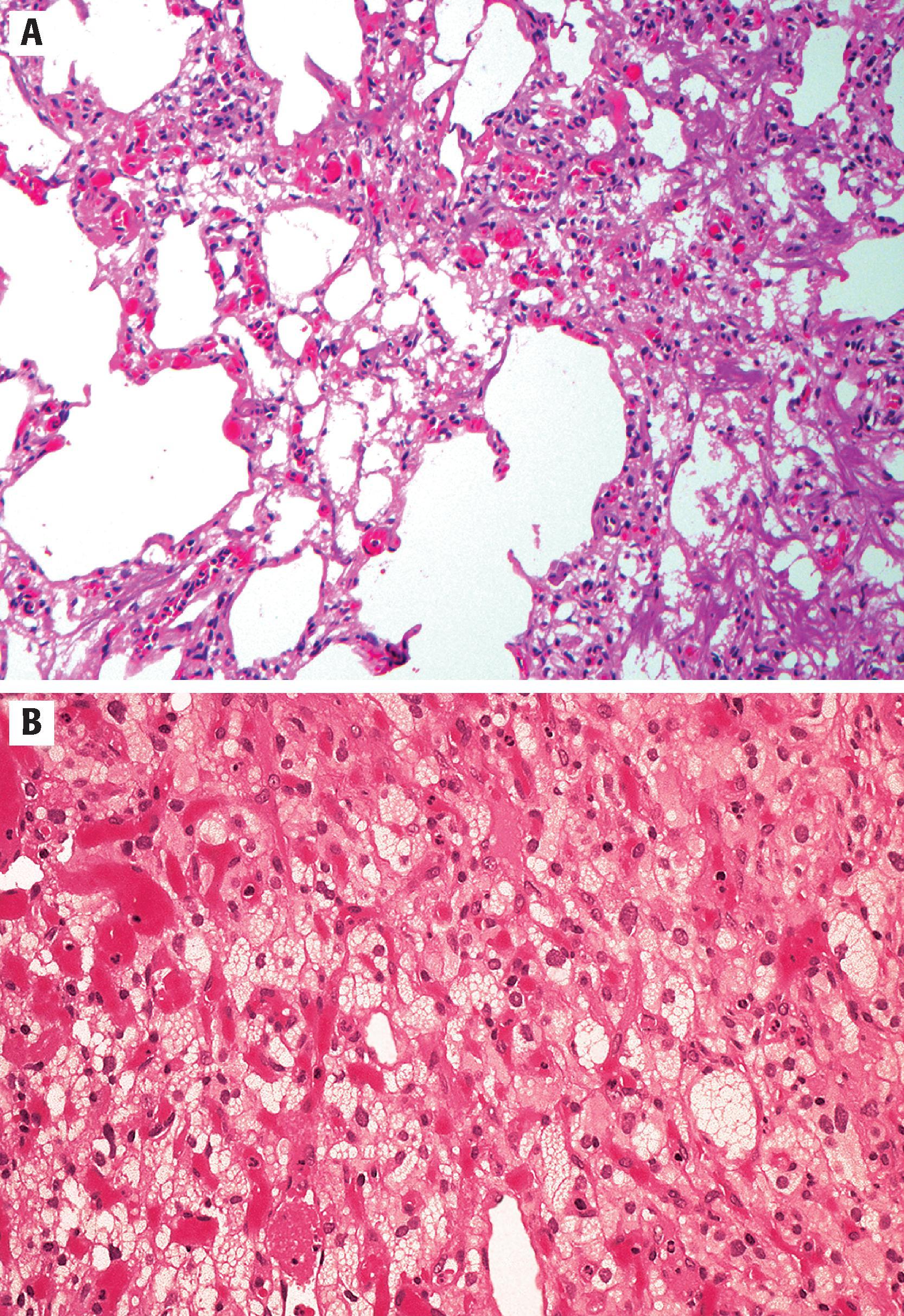
Well-circumscribed tumor with a cystic component and red (vascular) nodule(s)
May be yellow if lipid-rich
Two components: prominent capillary vasculature and stromal cells with vacuolated or lightly eosinophilic cytoplasm
Stromal cells may demonstrate focal nuclear pleomorphism
Mitoses and necrosis unusual
Adjacent parenchyma gliotic with Rosenthal fibers
Abundant cytoplasmic lipid droplets in stromal cells
Stromal cell histogenesis not known
Focal vimentin-positive; weak GFAP positivity of uncertain significance may be present
Stromal cells generally negative with factor VIII–related antigen, EMA, neurofilament, PAX8, PAX2, and keratin antibodies
Stromal cells positive for inhibin A, CD56, brachyury, and vascular endothelial growth factor
Von Hippel-Lindau cases (about 25% of tumors) associated with tumor suppressor gene on chromosome 3p25-26
Metastatic clear cell carcinoma (especially renal cell carcinoma in the setting of Von Hippel-Lindau disease)
Pilocytic astrocytoma
From a clinical and radiographic standpoint, pilocytic astrocytomas can resemble hemangioblastomas; however, the tumors look very different histologically. Occasionally, a biopsy sample taken at the edge of a hemangioblastoma with numerous Rosenthal fibers and piloid gliosis may be confused with pilocytic astrocytoma. Metastatic clear cell carcinoma of renal origin can also resemble hemangioblastoma. This resemblance is particularly problematic in the setting of Von Hippel-Lindau disease, where both lesions are more likely to appear. In general, renal cell carcinomas are EMA-, PAX8-, PAX2- and CD10-positive, may demonstrate areas of necrosis and mitotic activity, and do not stain with inhibin A.
Hemangioblastomas are considered benign lesions (WHO grade 1) and are amenable to gross total resection. Patients with Von Hippel-Lindau disease have a propensity for the development of multiple tumors.
Primary melanocytic lesions may be found at any age, with melanocytosis being most common during childhood, melanocytoma peaking during the fifth decade, and melanoma primarily present in adults. As primary conditions in the CNS, these lesions are relatively uncommon. Melanocytosis might be manifested as seizures, psychiatric problems, and symptoms related to increased intracranial pressure. Melanocytomas and primary malignant melanomas are characterized by increased intracranial pressure and focal neural deficits. Radiographically, melanocytosis may be marked by diffuse thickening and enhancement of the leptomeninges. Melanocytomas and melanomas may have variable findings radiographically, depending on the amount of hemorrhage and melanin contained within the tumor.
Diffuse or localized, benign or malignant tumors arising from leptomeningeal melanocytes; Includes three main entities: diffuse melanocytosis, melanocytoma, and melanoma
Melanocytosis and primary melanoma are very rare entities
Melanocytoma: 0.06% to 0.1% of brain tumors; annual incidence, 1 per 10 million population
Melanocytosis is a leptomeningeal-associated process.
Melanocytoma most common in the posterior fossa and cervical/thoracic spinal cord in the extramedullary intradural compartment.
Melanocytosis most common in childhood
Melanocytoma develops at any age, with a peak in the fifth decade and an F:M ratio of 1.5:1.
Primary melanoma occurs mostly in adults.
Melanocytosis is manifested as seizures, psychiatric problems, and increased intracranial pressure.
Melanocytomas and melanomas are characterized by increased intracranial pressure and focal neural deficits.
Melanocytosis: diffuse thickening and enhancement of the leptomeninges
Melanocytoma: isodense with gray matter, hyperintense on T1-weighted MRI, hypointense on T2-weighted MRI
Melanoma: variable, depending on the amount of hemorrhage
Melanin deposits: highlighted by hyperintensity on short-repetition time/short-echo time MRI
Melanocytosis (despite its histologic appearance) and melanoma have a poor outcome.
Melanoma is radio-resistant and readily metastasizes.
Melanocytoma: variable survival, prone to recur locally and invade local structures
Grossly, melanocytosis is characterized by black pigmentation of the leptomeninges. Melanocytomas and melanomas are relatively circumscribed lesions with variable degrees of pigmentation. Melanoma may also be marked by variable amounts of hemorrhage and necrosis.
Histologically, melanocytosis is characterized by a diffuse proliferation of nevoid cells in the leptomeninges ( Fig. 10.9A ). Focally, extension into the Virchow-Robin spaces may be present. Melanocytomas are marked by a proliferation of monomorphic-appearing cells that may be polygonal or spindled in configuration with round vesicular nuclei, prominent nucleoli, and a variable degree of cytoplasmic melanin (see Fig. 10.9B ). Melanomas, in contrast to melanocytomas, are generally more pleomorphic, have increased mitotic activity and an infiltrative growth pattern, and more frequently demonstrate evidence of necrosis (see Fig. 10.9C ). Ultrastructurally, all lesions are marked by the presence of melanosomes and a lack of junctions. By immunohistochemistry, all lesions are positive for S-100 protein, melan A (MART-1), SOX 10, and HMB978-0-323-71344-3.
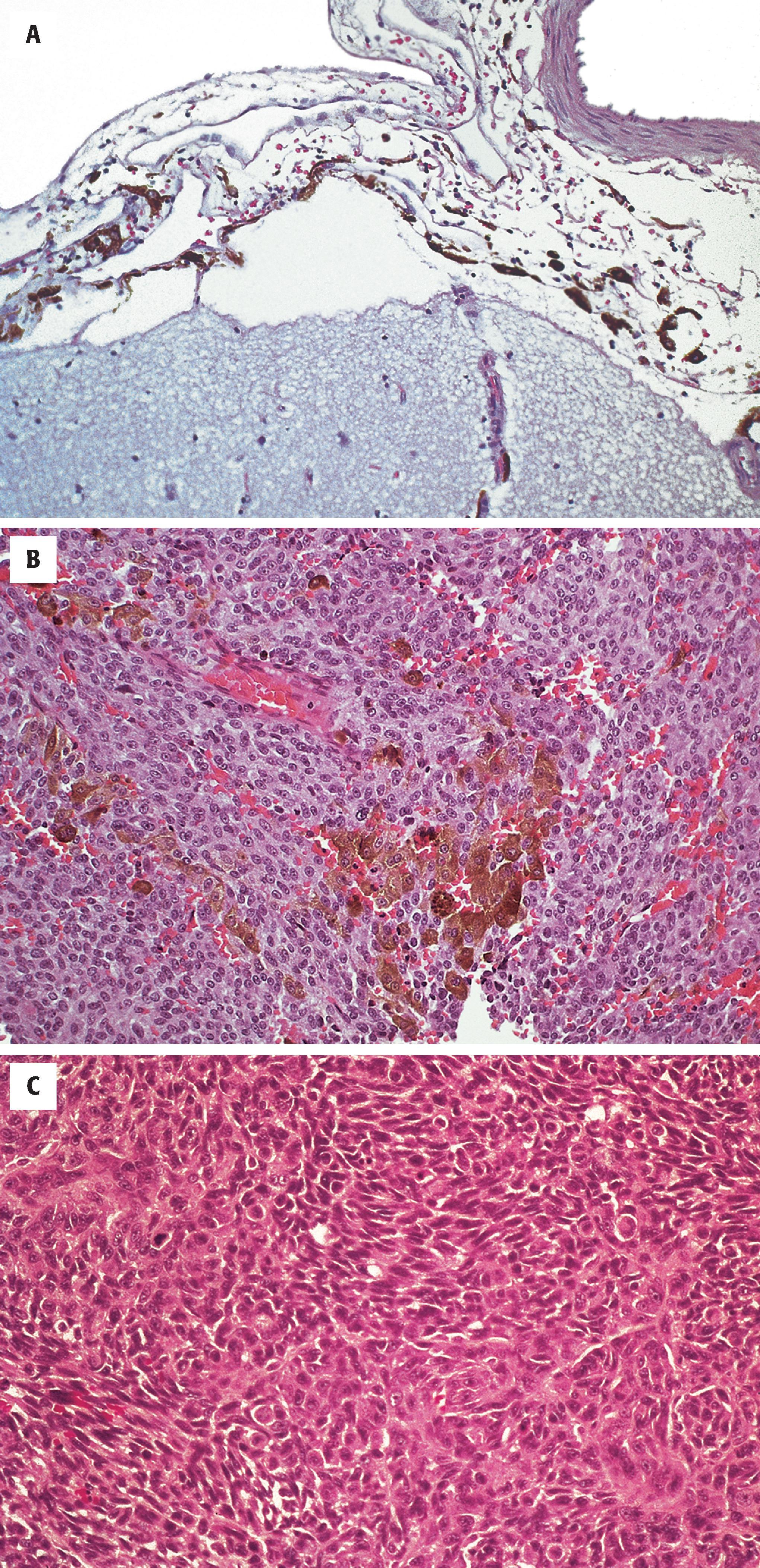
Melanocytosis: black-pigmented meninges
Melanocytoma and melanoma: single circumscribed lesions with variable pigmentation
Melanocytosis: diffuse or multifocal proliferation of uniform, polygonal nevoid cells in the leptomeninges, may focally extend into Virchow-Robin spaces
Melanocytoma: monomorphic cells (spindle to polygonal) with round vesicular nuclei, prominent nucleoli, and cytoplasmic melanin; only rare mitotic figures observed
Melanoma: more pleomorphism, mitotic activity, necrosis, and parenchymal infiltration than occurs with melanocytoma
Melanosomes in cytoplasm, no junctions, no interdigitating cytoplasmic processes
Positive for S-100 protein, melan A, SOX 10, HMB-45, and vimentin
Negative for GFAP, EMA, cytokeratins, and neurofilament protein
Neurocutaneous melanosis (combination of midline cutaneous nevi and melanocytosis) suggests a genetic basis for a subset of melanocytosis cases
Melanocytoma: mutations in GNAG or GNA11
Melanoma: NRAS mutation in childhood cases, less frequently encounter GNAQ or GNA11 mutations
Metastatic melanoma
Meningioma
Melanocytic differentiation in other primary CNS neoplasms (gliomas, medulloblastoma, schwannoma)
Differentiating melanin-poor melanocytomas and melanomas from other tumors may at times be difficult. The immunohistochemical profile is somewhat distinctive and can be helpful in excluding most other tumor types. A variety of other primary CNS neoplasms, including gliomas, medulloblastomas, and schwannomas, may focally contain melanin pigmentation.
Despite its rather bland histologic appearance, melanocytosis is often associated with a poor prognosis. Melanomas have a poor outcome, are generally refractory to radiotherapy, and have a propensity to readily metastasize. The prognosis of melanocytomas is somewhat more variable; a subset of these tumors recurs locally or undergoes malignant transformation.
Chordomas are relatively uncommon tumors that may arise at any age but are most commonly encountered in adults with a peak incidence in the fourth decade. The majority of tumors are located in either the sacrococcygeal or the clivus/spheno-occipital region. Sacral tumors are marked by signs and symptoms related to sphincter disturbance, neurologic deficits secondary to involvement of nerve roots, or pain. Tumors arising at the base of the skull are associated with headaches, diplopia, and cranial nerve palsies. Radiographically, tumors are generally osseodestructive and infiltrate adjacent tissues.
Tumor derived from notochord remnants
Relatively uncommon tumor
Most common sites: sacrococcygeal region (about half), clivus or spheno-occipital region (a third), and associated with articulating vertebrae
Any age, more common in adults
Sacral tumors are marked by pain, sphincter disturbance, and neural deficits secondary to involvement of nerve roots.
Base of skull tumors are characterized by headaches, diplopia, and cranial nerve palsies.
Osseodestructive mass with infiltration into adjacent soft tissue
Wide surgical resection recommended; local recurrence with subtotal resection
Radiotherapy for subtotally resected tumors
Minority of tumors metastasize to the lung, nodes, and skin.
Minority of tumors degenerate or dedifferentiate into sarcoma.
Younger patients have a better prognosis.
Grossly, chordomas are infiltrative, lobulated masses with a mucoid appearance on sectioning. Focal areas of cartilaginous differentiation (chondroid chordoma) may be observed ( Fig. 10.10A ).
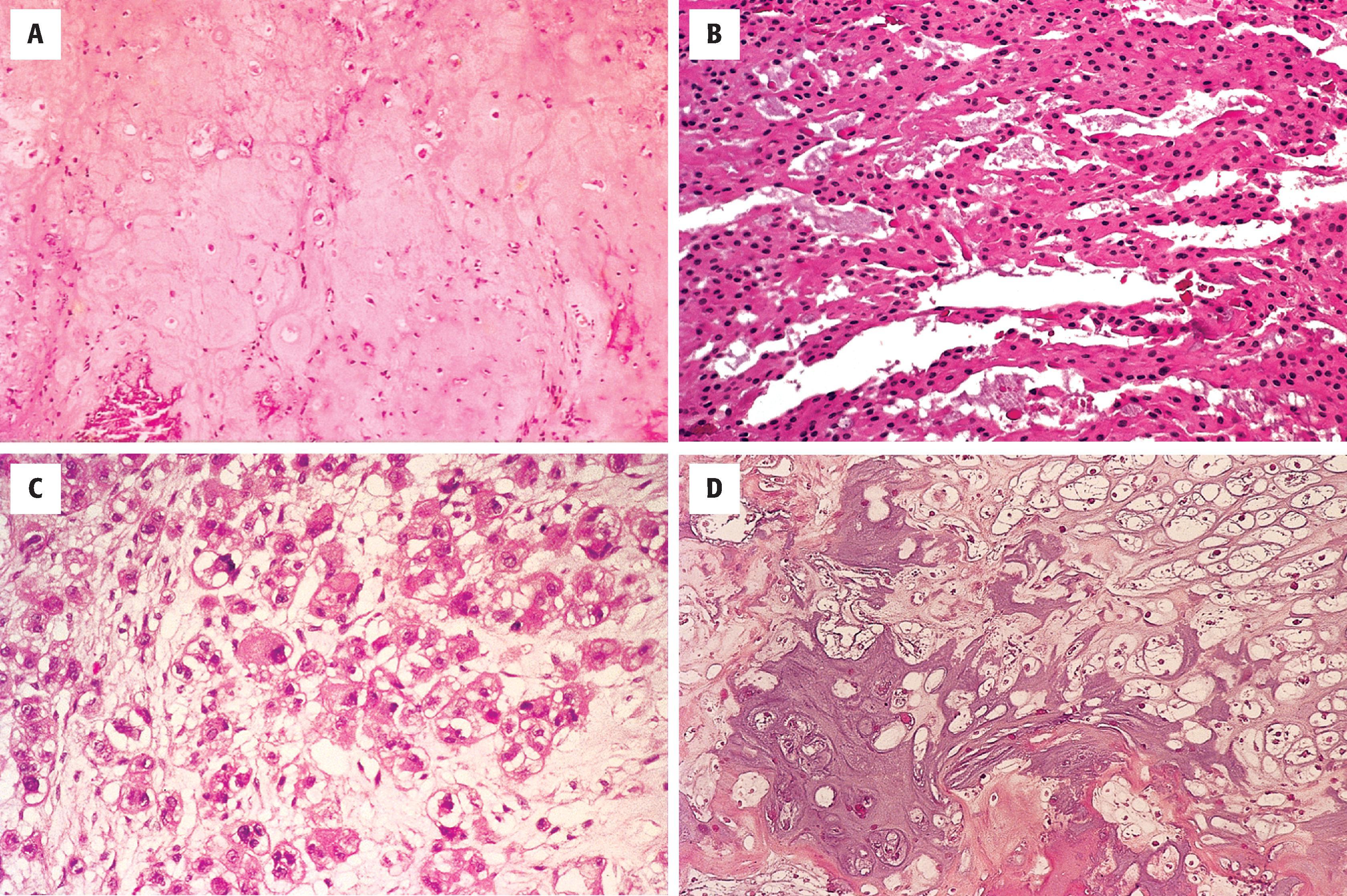
Histologically, tumors are marked by a lobulated architectural pattern with fibrovascular septa. Epithelioid cells are arranged in cords or rows (see Fig. 10.10B ). Many of the cells may have a prominently vacuolated cytoplasm (physaliphorous cells) (see Fig. 10.10C ), and occasional mitotic figures and mild nuclear pleomorphism may be present. Ultrastructurally, the tumors are characterized by abundant cytoplasmic mucus vacuoles and desmosomal junctions. Tumors stain positively with antibodies to vimentin, cytokeratin, EMA, brachyury, and S-100 protein. Rare anaplastic tumors (particularly in children) may demonstrate INI-1 loss.
Infiltrative, bone-based, lobulated mass
Mucoid appearance
Cartilaginous tissue in the chondroid variant
Lobulated architecture with fibrovascular septa
Epithelioid cells arranged in cords or rows against mucoid stroma
Physaliphorous cells with bubble-like vacuolated cytoplasm
Occasional mitotic figures and mild nuclear pleomorphism
Focal cartilaginous differentiation (chordoid chordoma)
Abundant cytoplasmic mucus vacuoles and desmosomal junctions
Positive with antibodies to vimentin, cytokeratins, EMA, brachyury, and S-100 protein
May show loss of chromosome 3p and isochromosome 1q
Chondrosarcoma
Chordoid meningioma
Metastatic mucinous adenocarcinoma
Metastatic mucinous adenocarcinoma may resemble chordoma but generally does not stain with S-100 protein. Chordoid meningiomas may superficially resemble chordoma, although they typically arise in other locations and do not usually demonstrate prominent cytokeratin positivity. In tumors with a chondroid component, differentiation from chondrosarcoma may be an issue. In general, the cartilaginous component in chondrosarcoma appears malignant with large pleomorphic nuclei (see Fig. 10.10D ). Chondrosarcomas are cytokeratin- and EMA-negative.
Treatment of chordomas entails wide excision because subtotally resected tumors tend to recur locally. A minority of tumors metastasize to distant sites, including the lung, lymph nodes, and skin. Radiotherapy is often used in the management of subtotally resected, recurrent tumors. Rare tumors dedifferentiate into high-grade sarcomas and have a particularly poor prognosis.
Choroid plexus tumors account for less than 1% of all brain tumors and approximately 2% to 4% of brain tumors in children. Approximately 80% of choroid plexus tumors arise in children, with the majority being situated in the lateral ventricles. There is no definite sex predilection for choroid plexus neoplasms. Because of their intraventricular location, they are most commonly associated with signs and symptoms related to hydrocephalus and increased intracranial pressure. Radiographically, they are hyperintense, contrast-enhancing lesions.
Papillary, intraventricular neoplasm derived from choroid plexus epithelium
0.4% to 0.6% of all brain tumors
2% to 4% of all brain tumors in children
Average annual incidence of 0.3 per 1,000,000
Intraventricular location: 50% lateral ventricle, 5% third ventricle, and 40% fourth ventricle; rarely found in spinal cord or other ectopic locations
80% of choroid plexus tumors arise in children
80% of lateral ventricle tumors develop in the first two decades; fourth ventricle tumors seen in all age groups
M:F ratio for lateral ventricle tumors, 1:1; for fourth ventricle tumors, 3:2
Signs and symptoms related to hydrocephalus and increased intracranial pressure
Hyperdense, contrast-enhancing tumor with hydrocephalus
Papillomas are low grade (WHO grade 1) and curable by surgery.
Carcinoma (WHO grade 3) has a poor outcome with a 40% survival rate at 5 years.
Gross total resection is the treatment of choice for carcinoma.
Poor prognosis associated with mitosis, necrosis, brain invasion, and absent/decreased transthyretin and S-100 immunostaining.
Grossly, papillomas are somewhat circumscribed papillary masses. In contrast, choroid plexus carcinomas are solid masses frequently punctuated with necrosis and an infiltrative margin.
Histologically, choroid plexus papillomas are characterized by a proliferation of bland choroid plexus epithelial cells lining fibrovascular cores ( Fig. 10.11A ). Minimal mitotic activity and cytologic atypia are present. Atypical papillomas (WHO grade II) are marked by two or more mitoses per 10 high-power fields (see Fig. 10.11B ). In contrast, carcinomas are marked by nuclear atypia, increased mitotic activity, increased cellularity, necrosis, loss of papillary pattern, and brain invasion (see Fig. 10.11C ). Ultrastructurally, choroid plexus tumor cells are characterized by microvilli, tight junctions, and interdigitating membranes. By immunohistochemistry, tumors generally stain with antibodies to keratin and S-100 protein. Focal GFAP immunoreactivity and immunostaining with transthyretin may also be observed.
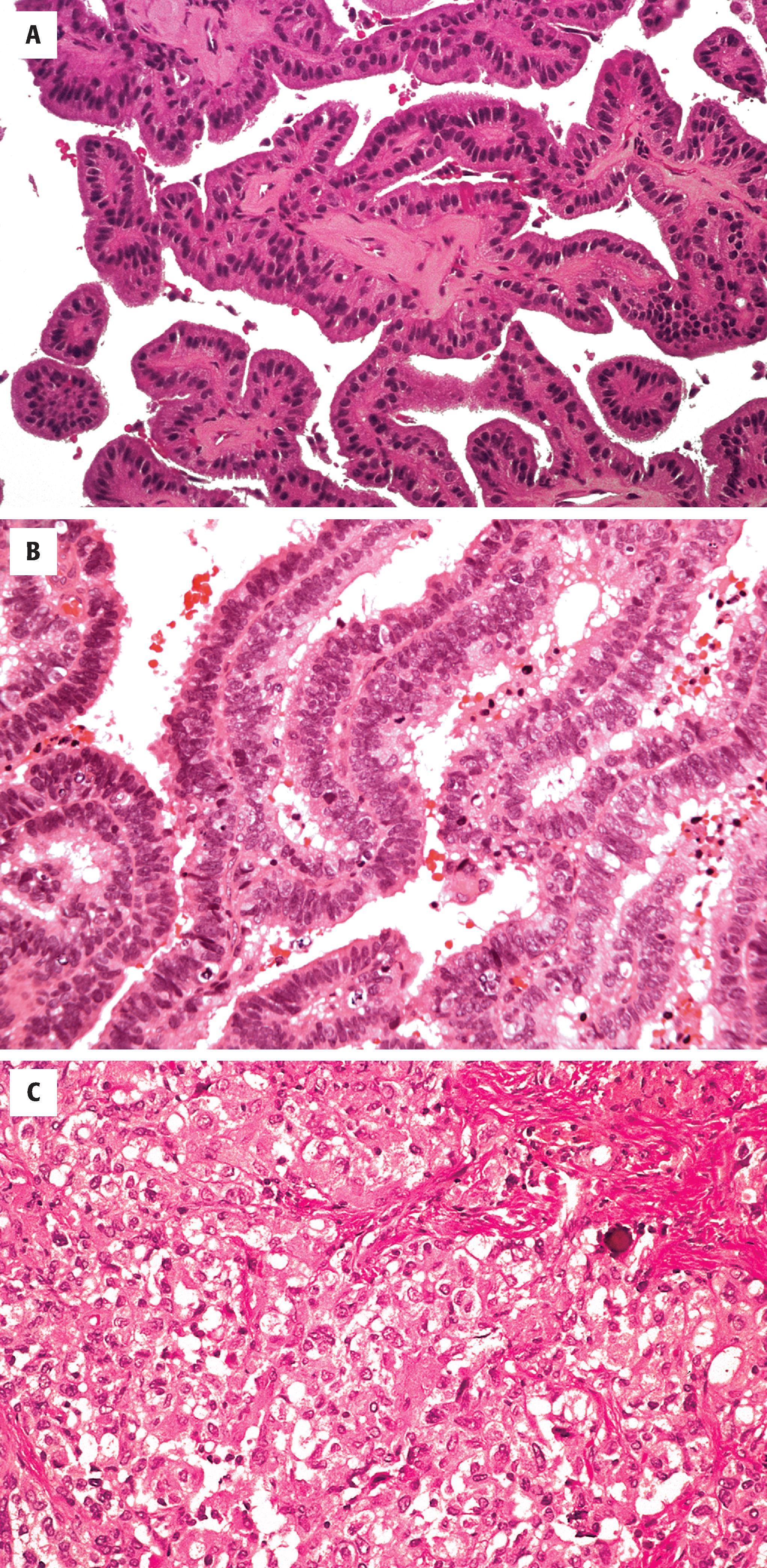
Papillomas: intraventricular, circumscribed papillary masses
Carcinomas: infiltrative solid mass with necrosis
Papillomas (WHO grade 1) marked by fibrovascular papillary cores lined by stratified epithelial cells
Minimal cytologic atypia and mitotic activity in papillomas
Rare papillomas may demonstrate oncocytic and mucinous change, melanin, tubular architecture, and metaplastic cartilage or bone.
Atypical choroid plexus papilloma (WHO grade 2) marked by two or more mitoses per 10 high-power fields
Carcinomas (WHO grade 3) marked by frank signs of malignancy including at least four of the following: nuclear pleomorphism, increased mitotic activity (>5 mitoses per 10 high-power fields), increased cellularity, necrosis, and blurring of papillary pattern. Brain invasion common
Interdigitating membranes, microvilli, tight junctions, and some cells with cilia
Positive for vimentin, keratin, and S-100 protein; subset focally positive for GFAP and transthyretin
SV40 DNA sequences in about 50% of tumors
Hyperdiploidy with genes on chromosomes 7, 9, 12, 15, 17, and 18
About 50% of carcinomas have TP53 mutations.
Metastatic carcinoma
Ependymoma
Particularly in children, differentiation of papillary ependymoma from choroid plexus papilloma may at times be problematic. In general, papillary ependymomas have a gliovascular core, demonstrate more widespread GFAP immunoreactivity, and are marked by the formation of perivascular pseudorosettes and true ependymal rosettes. Metastatic papillary carcinomas are in the differential diagnosis of choroid plexus carcinomas. Distinction of these two tumor types may be quite difficult on occasion. Most metastatic carcinomas occur in older patients and are less likely to be positive for transthyretin, S-100 protein, and GFAP.
Choroid plexus papillomas are low-grade lesions (WHO grade 1) that are potentially curable by surgical excision. Choroid plexus carcinomas are higher-grade lesions (WHO grade 3) with a poor outcome and a 40% 5-year survival rate. Gross total resection is the therapeutic modality of choice for carcinomas and may be followed by radiation therapy, chemotherapy, or both.
Neurocytomas can arise at any age but have a peak incidence between the third and fifth decades. Classically, these tumors are located in the lateral ventricles or third ventricle and show no obvious sex predilection. Symptoms are usually related to increased intracranial pressure. Radiographically, these tumors appear as contrast-enhancing or isointense lesions on computed tomography (CT) and may be calcified or focally cystic.
Low-grade, neuronally differentiated neoplasm, typically in an intraventricular location
0.25% to 0.5% of intracranial tumors
Most located in the lateral ventricles or third ventricle; rare cases are extraventricular (mostly commonly frontal lobes) or cerebellar
Equal sex distribution
Age range: infancy to seventh decade, peak incidence between 20 and 40 years of age
Become a Clinical Tree membership for Full access and enjoy Unlimited articles
If you are a member. Log in here